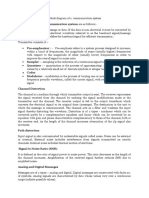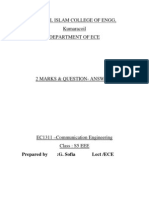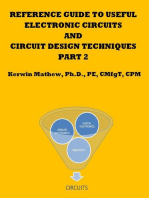Experiment No. - 2: Object
Experiment No. - 2: Object
Uploaded by
Gaurav Kumar GoyalOriginal Description:
Original Title
Copyright
Available Formats
Share this document
Did you find this document useful?
Is this content inappropriate?
Report this DocumentCopyright:
Available Formats
Experiment No. - 2: Object
Experiment No. - 2: Object
Uploaded by
Gaurav Kumar GoyalCopyright:
Available Formats
PAM
February 1, 2012
EXPERIMENT NO. - 2
OBJECT:
Study of PAM generation and detector and observe characteristics of both single and dual pulse amplitude modulation.
COMPONENT REQUIRED:- 9V D.C. at 100 mA -IC regulated power supply internally connected - Variable frequency sampling pulse generator -Sine wave audio frequency modulating signal generator - PAM modulator circuit based on operational amplifier - PAM demodulator circuit based on a point connected diode and operational amplifier -The unit is operative on 230V 10% at 50Hz A.C. Mains,
THEORYModulation is the process of varying one or more properties of a high-frequency periodic waveform, called the carrier signal, with respect to a modulating signal. This is done in a similar fashion as a musician may modulate a tone (a periodic waveform) from a musical instrument by varying itsvolume, timing and pitch. The three key parameters of a periodic waveform are its amplitude ("volume"), its phase ("timing") and
its frequency ("pitch"), all of which can be modified in accordance with a low frequency signal to obtain the modulated signal. Typically a high-frequency sinusoid waveform is used as carrier signal, but a square wave pulse train may also occur. In telecommunications, modulation is the process of conveying a message signal, for example a digital bit stream or an analog audio signal, inside another signal that can be physically transmitted. Modulation of a sine waveform is used to transform a baseband message signal into a passband signal, for example low-frequency audio signal into a radio-frequency signal (RF signal). In radio communications, cable TV systems or the public switched telephone 2. 1
PAM
February 1, 2012
network for instance, electrical signals can only be transferred over a limited passband frequency spectrum, with specific (non-zero) lower and upper cutoff frequencies. Types of Modulation:-
Analog communication Digital communication
Ana log communication:
An analog or analogue communication consist of any continuous signal for which the time varying feature (variable) of the signal is a representation of some other time varying quantity, i.e., analogous to another time varying signal. It differs from a digital signal in terms of small fluctuations in the signal which are meaningful. Analog is usually thought of in an electrical context; however, mechanical, pneumatic, hydraulic, and other systems may also convey analog signals. An analog signal uses some property of the medium to convey the signal's information. For example, an aneroid barometer uses rotary position as the signal to convey pressure information. Electrically, the property most commonly used is voltage followed closely by frequency, current, and charge. Any information may be conveyed by an analog signal; often such a signal is a measured response to changes in physical phenomena, such as sound, light, temperature, position, or pressure, and is achieved using a transducer.
Digital communication:
In digital communication the term digital signal is used, to refer a discrete-time signal that have a discrete number of levels, for example a sampled and quantified analog signal, or to the continuous-time waveform signals in a digital system, representing a bit-stream. In the first case, a signal that is generated by means of a digital modulation method which is considered as converted to an analogue signal, while it is considered as a digital signal in the second case.
2. 2
PAM Modulation
February 1, 2012
Continuous wave
Pulse
Amplitude
Angle
Pulse amplitude Phase Pulse position
Pulse time
Pulse code
Frequency
Pulse width
Need For Modulation
1. Frequency Multiplexing Multiplexing may be achieved by translating each one of the original signal to a different frequency range. Suppose one signal is translated to the frequency range f1 to f2. The second of the range f1 to f2. And so on. If these new frequency ranges do not overlap, then the signal may be separated at the receiving end by appropriate band pass filter. 2. Practicability of Antennas When free space is the communication channel radiate and receive the signal. It turns out that antennas operate effectively only when their dimensions are of the order of magnitude of the wavelength of the signal being transmitted. A signal strength 1 kHz corresponds to a wave length of 300,000m, an entirely impractical length. The required length may be reduced to the point of practicability by translating the audio tone to a higher frequency.
3. Narrow Banding
The process of the frequency translation may be used to change wideband signal into a narrow band signal which may well be more conveniently processed. The term wideband and narrowband are being used here to refer not to an absolute range of frequencies but rather to the fractional change in frequency from one band edge to other.
2. 3
PAM
February 1, 2012
4. Common Processing
It may happen that we may have to process, in turn a number of signals similar in general character but occupying different spectral range. It will then be necessary as we go from signal to signal, to adjust frequency range of our processing apparatus to correspondence to the frequency range of the signal to be processed. If processing apparatus is rather elaborate, it may well be wiser to leave the processing apparatus to operate in some fixed frequency range and instead to translate the frequency range of each signal in turn to correspond to fixed frequency.
Advantage of digital communication:1. Digital communication is more rugged then analog communication because it can withstand channel noise and distortion is within limits. 2. We can use regenerative repeaters in the digital communication. The distance over which an analog message can be transmitted is limited by transmitted power. 3. Digital hardware implementation is flexible and permits the use of microprocessor, miniprocessor, digital switching and large scale integrated circuit. 4. Digital signal can be coded to yield extremely low error rate and highly feudality and as well as privacy. 5. Digital signal is inherently more efficient then analog in realizing the exchange of SNR and bandwidth. 6. Digital signal storage is relatively easy and inexpensive.
2. 4
PAM
February 1, 2012
PULSE AMPLITUDE MODULATION (PAM): This training is concerned with this type of pulse modulation; therefore lets look at it in further detail. Here the amplitude of the pulse is varied according to the modulating signal. This corresponds to amplitude modulation of the continuous wave. The PAM waveform can be two types. DUAL POLARITY PAM If we sample the modulating signal by dual polarity sampling pulses as then resulting PAM waveform is also dual polarity types . SINGLE POLARITY PAM If we sample the modulating single whose DC level has been raised to a positive value say +V1 from 0 volts and sample it with singal polarity pulses Then the resulting waveform is also a single polarity type. In this training board we produce single polarity PAM.
Fig .2.1
The frequency spectrum of the sampling pulsesshowsPAM waveform. The frequency spectrum of PAM signal shows that the modulating frequency fm and various sidebands fcfm maintain their individuality, that is, fm does not spread into the lower sideband region 2. 5
PAM
February 1, 2012 fmfc-fm
around fc or fc+fm does not spread into the lower sideband region around 2fc if: or fc2fm.
Fig: 2.2 Demodulation of pulse amplitude modulation
We can conclude that the modulating signal can be extracted from the PAM simply by a diode and a low pass filter with its cut of frequency at Fm.
2. 6
PAM
February 1, 2012
BLOCK DIAGRAM OF PAM MODUATOR AND DEMODULATOR
FIG: 2.3 circuit diagram of PAM
2. 7
PAM
February 1, 2012
Practical circuit of pulse amplitude modulation
V1 0 120 Vrms 60 Hz 0 4 R2 4.7k
A + _
XSC1
Ext Trig + _ B + _
2 Q1 5 V2 -1 V 1 V 0.5msec 1msec 0
FIG: 2.4 Here V1is modulating signal. V2 is the carrier signal.
R3 3.3k
R1 22k
1 SMBT2222A C1 100nF
The modulating and the demodulated output is obtained on the 1st and 2nd channel of oscilloscope respectively.
WORKING:The block diagram of pulse amplitude modulator based on operational amplifier (ic-741) is show on in fig. we know that the train of pulses corresponding to the samples of each signal are modulated in amplitude in accordance with the signal itself. Accordingly, the scheme of sampling is called pulse amplitude modulation. In this, the modulating signal is feds to pin-3 of op-amp. through sine wave generator. The sampling pulses are feds to pin-6 of op-amp. 10k resistor.+9v supply is feds to pin-7 through 100f capacitor. The pin-2 of 741 connected to two resistor of 2k2 , 4k7 & four diodes (1n4148). The pin-2
2. 8
PAM
February 1, 2012
provides trigger pulse to 741 through diode and resistor. The o/p of 741 depends on the amplitude of the external trigger pulse applied to this pin. Thus, we obtained PAM waveform. When we feds the Pam waveform to the i/p of demodulator, we obtained modulating signal. The block diagram of Pam demodulator is shown in fig. The Pam demodulator is low pass filter which passes only low frequency modulating signal shows the effects of the frequency of the frequency of sampling pulses on the recovered modulating signal after flow frequency sampling pulses. RESULT:Hence, I have studied and performed pulse amplitude modulation and demodulation. IMPORANTS POINT: Frequency of carrier must be higher than message. Amplitude of pulse must be varied according to sinusoidal wave, due to some distortions in the negative half change in amplitude of pulse appears less.
2. 9
You might also like
- UNIT5 Fundamentals of Communication EngineeringDocument20 pagesUNIT5 Fundamentals of Communication EngineeringUpender Rao Sunkishala100% (4)
- Optical Communication Certification: Optical Communication Professional (OC-P) Ocp1 Release 1.2.1 Course OutlineDocument4 pagesOptical Communication Certification: Optical Communication Professional (OC-P) Ocp1 Release 1.2.1 Course OutlineAnonymous 1UM1sIIf0% (1)
- Microsoft Azure Cloud For Solution ArchitectsDocument28 pagesMicrosoft Azure Cloud For Solution ArchitectsMihai CoscodanNo ratings yet
- Ac VivaDocument8 pagesAc VivaSandyNo ratings yet
- Pulse Amplitude ModulationDocument10 pagesPulse Amplitude ModulationSara AhmedNo ratings yet
- Theory:-: Experiment No-1 Objective Apparatus RequiredDocument23 pagesTheory:-: Experiment No-1 Objective Apparatus RequiredAnand SantNo ratings yet
- Comparison Between AM, PM and FM: Term Paper OnDocument20 pagesComparison Between AM, PM and FM: Term Paper OnAshish VaniyaNo ratings yet
- Basic of Communication EngineeringDocument66 pagesBasic of Communication EngineeringRohitUikeyNo ratings yet
- Analog and Digital CommunicationDocument20 pagesAnalog and Digital CommunicationnofeelingrahulNo ratings yet
- Acs - Analog Communication Systems ManualDocument56 pagesAcs - Analog Communication Systems ManualAmandeep SinghNo ratings yet
- Amplitude Modulation: - Introduction To Modulation: - Detection of AM Signals: - Costas ReceiverDocument62 pagesAmplitude Modulation: - Introduction To Modulation: - Detection of AM Signals: - Costas ReceiverShikhar AgarwalNo ratings yet
- Frequency Modulation - Demodulation & Phase ModulationDocument10 pagesFrequency Modulation - Demodulation & Phase ModulationClarence Billy Bijug100% (1)
- HjajuDocument11 pagesHjajuaditya.bhandari2104No ratings yet
- Analog Communication Basic Questions AnswerDocument13 pagesAnalog Communication Basic Questions AnswerSourav Ghosh100% (1)
- Analog and Digital CommunicationDocument36 pagesAnalog and Digital Communicationajas777BNo ratings yet
- It 1202 - Principles of CommunicationDocument20 pagesIt 1202 - Principles of CommunicationainugiriNo ratings yet
- AC Lab PDocument48 pagesAC Lab PspbezawadaNo ratings yet
- Adc Unit 4 MaterialDocument70 pagesAdc Unit 4 MaterialsrinithaNo ratings yet
- Pce Qps 2022Document18 pagesPce Qps 2022Tanishk SuvarnaNo ratings yet
- Channel DistortionDocument3 pagesChannel DistortionBlessonThomasNo ratings yet
- Experiment Number 1 Amplitude Modulation & DemodulationDocument3 pagesExperiment Number 1 Amplitude Modulation & DemodulationAlasadNo ratings yet
- Pre-LAB 5: Amplitude ModulationDocument6 pagesPre-LAB 5: Amplitude ModulationA RNo ratings yet
- Lovely Professional UniversityDocument14 pagesLovely Professional Universityshailesh singhNo ratings yet
- Electronics and Communication Lab Manual PDFDocument41 pagesElectronics and Communication Lab Manual PDFtesterNo ratings yet
- IT 2202 PocDocument40 pagesIT 2202 PocPaayal SasiNo ratings yet
- Modulation: Frequency. Recall From Previous Chapters (2, 6, 9) That We Can Write This Sinusoidal Carrier C (T) TDocument24 pagesModulation: Frequency. Recall From Previous Chapters (2, 6, 9) That We Can Write This Sinusoidal Carrier C (T) TDuong Phi ThucNo ratings yet
- EC1311 Communication EngineeringDocument23 pagesEC1311 Communication EngineeringVidya NeemuNo ratings yet
- Prelab #1 (FM) AlkishreioDocument3 pagesPrelab #1 (FM) Alkishreioabdoag1691998No ratings yet
- Pulse Amplitude Modulation (PAM) - Working, Types & Its ApplicationsDocument15 pagesPulse Amplitude Modulation (PAM) - Working, Types & Its ApplicationsSubhajit Das100% (1)
- Adc Lab Manual STUDENTDocument59 pagesAdc Lab Manual STUDENTramNo ratings yet
- Unit 2 - Analog and Digital Communication - WWW - Rgpvnotes.inDocument37 pagesUnit 2 - Analog and Digital Communication - WWW - Rgpvnotes.inpeacepalharshNo ratings yet
- Unit 2 - Analog and Digital Communication - WWW - Rgpvnotes.inDocument31 pagesUnit 2 - Analog and Digital Communication - WWW - Rgpvnotes.inBatukNo ratings yet
- DCOM Lab ManualDocument45 pagesDCOM Lab ManualSyeda InaasNo ratings yet
- Pulse Amplitude ModulationDocument10 pagesPulse Amplitude ModulationgeoffreyalleyneNo ratings yet
- B.SC Electronics D2 P4 (2020) SolutionsDocument15 pagesB.SC Electronics D2 P4 (2020) SolutionsShubham KeshriNo ratings yet
- Communication Engineering 2 MarksDocument38 pagesCommunication Engineering 2 MarksNandhini100% (2)
- UNIT 3 Onemarks Eng Prot CeDocument4 pagesUNIT 3 Onemarks Eng Prot CeSukesh RNo ratings yet
- IT 2202 PocDocument41 pagesIT 2202 PocapecevsbNo ratings yet
- Communication Systems Lab ManualDocument74 pagesCommunication Systems Lab ManualHailin Arumiga100% (1)
- 4 - EE Com 314Document43 pages4 - EE Com 314jorgenovachrolloNo ratings yet
- ANLOG Communication Full Manual...Document54 pagesANLOG Communication Full Manual...ydsraju100% (1)
- ModulationDocument41 pagesModulationNimma Avanthi100% (1)
- Pulse Amplitude ModulationDocument4 pagesPulse Amplitude ModulationRomwald LihakangaNo ratings yet
- Analog CommunicationDocument48 pagesAnalog CommunicationBrzata Ptica100% (1)
- ADC Book Part 2Document170 pagesADC Book Part 2shahabazNo ratings yet
- BATCH 2018-2022 Submitted By: SubmittedtoDocument27 pagesBATCH 2018-2022 Submitted By: SubmittedtoshantanuNo ratings yet
- PULSEDocument6 pagesPULSESuresh JKNo ratings yet
- Lab Viva SolvedDocument8 pagesLab Viva SolvedMuhammad Umair100% (2)
- Labview Mini Project Report: SathyabamaDocument15 pagesLabview Mini Project Report: SathyabamaUDHAYASURYA GNo ratings yet
- Digital Modulation TechniquesDocument34 pagesDigital Modulation TechniquesAkash ModiNo ratings yet
- Sampling Theorem Verification: Electronics & Communication EngineeringDocument0 pagesSampling Theorem Verification: Electronics & Communication Engineeringagama1188No ratings yet
- SamplingDocument15 pagesSamplingKaishavi UmrethwalaNo ratings yet
- AC ReportDocument19 pagesAC ReportshriyaNo ratings yet
- Ce Unit Ii RRDocument54 pagesCe Unit Ii RRsriramachandran2011No ratings yet
- Am ModulationDocument9 pagesAm ModulationBrzata PticaNo ratings yet
- Analysis and Design of Multicell DC/DC Converters Using Vectorized ModelsFrom EverandAnalysis and Design of Multicell DC/DC Converters Using Vectorized ModelsNo ratings yet
- Reference Guide To Useful Electronic Circuits And Circuit Design Techniques - Part 2From EverandReference Guide To Useful Electronic Circuits And Circuit Design Techniques - Part 2No ratings yet
- 6th STD Social 1st Term Book Back Questions With AnswersDocument20 pages6th STD Social 1st Term Book Back Questions With AnswersShane Bond0% (1)
- 713 - No 30 Every Child Should Have A Mobile Phone (Junior)Document4 pages713 - No 30 Every Child Should Have A Mobile Phone (Junior)noviNo ratings yet
- Chapter 11 Intro To ControlnetDocument67 pagesChapter 11 Intro To ControlnetShahid HussainNo ratings yet
- AIS Over WiFi With The DT-06 ModuleDocument2 pagesAIS Over WiFi With The DT-06 ModuleAbu Syeed Md. Aurangzeb Al MasumNo ratings yet
- Manual QuantumXDocument224 pagesManual QuantumXailtonmecaNo ratings yet
- Firewire PresentationDocument15 pagesFirewire PresentationsezinevivianeNo ratings yet
- Um1713 User Manual: Developing Applications On Stm32Cube With Lwip Tcp/Ip StackDocument41 pagesUm1713 User Manual: Developing Applications On Stm32Cube With Lwip Tcp/Ip Stackc.cesco8703No ratings yet
- Calico For Kubernetes Networking - The Basics & Examples - Palark - BlogDocument13 pagesCalico For Kubernetes Networking - The Basics & Examples - Palark - Blogtemporal11No ratings yet
- O Manual Do Hacker Do CarroDocument122 pagesO Manual Do Hacker Do CarroSergio Greiso100% (1)
- Hot Standby Router Protocol Using Cisco Packet Tracer: School of ComputingDocument17 pagesHot Standby Router Protocol Using Cisco Packet Tracer: School of ComputingmkrNo ratings yet
- Storage Manager Storage Center Administrator's GuideDocument174 pagesStorage Manager Storage Center Administrator's GuidePerizinan ISR Ditjen SDPPINo ratings yet
- Splunk Course NotesDocument70 pagesSplunk Course NotesKaniNo ratings yet
- Cambium - t3 User Group Conference PPT Slides Sept 22nd 23rd 2015Document17 pagesCambium - t3 User Group Conference PPT Slides Sept 22nd 23rd 2015javierdb2012No ratings yet
- Omap l138Document287 pagesOmap l138Pritesh MandaviaNo ratings yet
- Blade Servers Comparison Dell Vs Hpe Vs Lenovo Vs HuaweiDocument4 pagesBlade Servers Comparison Dell Vs Hpe Vs Lenovo Vs HuaweiYudy UtamaNo ratings yet
- Application Development Using Heroku: Prepared By: Rupesh Sharma (1505053)Document12 pagesApplication Development Using Heroku: Prepared By: Rupesh Sharma (1505053)Rupesh SharmaNo ratings yet
- Sample Program: XGB-INV IG5A (RS-485 Modbus RTU)Document4 pagesSample Program: XGB-INV IG5A (RS-485 Modbus RTU)Roozbeh BahmanyarNo ratings yet
- Mysql Backup ZRM Over InternetDocument16 pagesMysql Backup ZRM Over InternetChristopher MontesNo ratings yet
- BER-1560 Data Transmission AnalyzerDocument6 pagesBER-1560 Data Transmission Analyzermnolasco2010No ratings yet
- 2015 Midterm 1 Exam SolutionDocument10 pages2015 Midterm 1 Exam SolutionfikaduNo ratings yet
- Auth Basic 1Document4 pagesAuth Basic 1Saikiran KiranNo ratings yet
- Introduction To AWS DDoS Attacks - DetailedDocument8 pagesIntroduction To AWS DDoS Attacks - Detailedsoumya.mettagalNo ratings yet
- TradeDocument12 pagesTraderajendraNo ratings yet
- Using HBAnyware With PowerShell ScriptsDocument2 pagesUsing HBAnyware With PowerShell ScriptsjjivkovNo ratings yet
- Nutanix TN 2072 ESXi AHV Migration Version 2.2Document23 pagesNutanix TN 2072 ESXi AHV Migration Version 2.2Alejandro DariczNo ratings yet
- NCM Mci 6.5Document54 pagesNCM Mci 6.5tareqNo ratings yet
- Image Steganography (3 Way Encryption)Document5 pagesImage Steganography (3 Way Encryption)Anonymous hpde67wuI6No ratings yet
- Potential Client ListDocument1 pagePotential Client ListHaley GuietteNo ratings yet

























































































